A power rack is just the beginning when it comes to building a killer home gym. Here is a breakdown of the best attachments for your rack, including accessories for increased safety, more exercises, and storage.
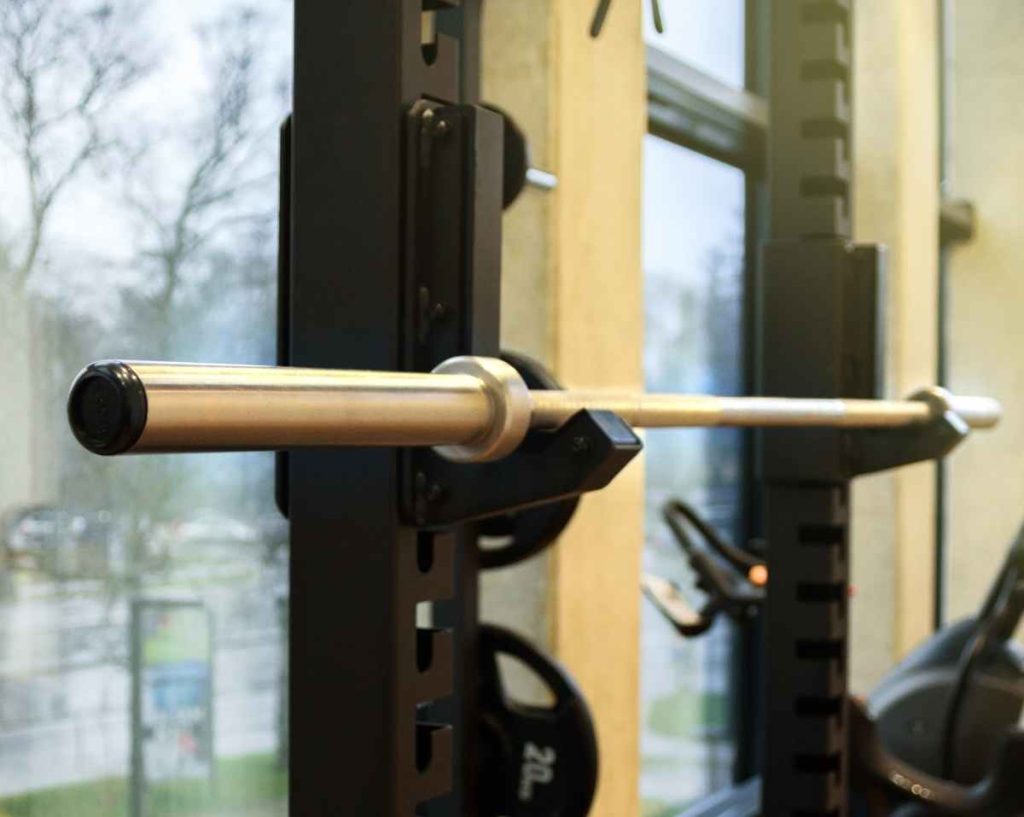
The squat rack or power rack is the centerpiece of your home gym.
But most new rack owners don’t realize just how much more they can squeeze out of their investment.
I’m talking about more exercises, safer workouts, and more effective lifting.
Sounds good, right?
In this guide, I’ll guide you through the different types of power rack attachments, the essential ones, the “nice to have” attachments, and the really “nice to have” attachments and accessories for your rack.
Let’s get to pimping out your power rack with some killer attachments and accessories.
Types of Power Rack Attachments
Before we jump into the long list of attachments, let’s break down the three categories of attachments for your power rack.
Safety attachments. These help you lift safely and protect your lifting equipment. Safety doesn’t take a holiday and all that. These are the absolutely essential accessories for your rack.
Storage attachments. Keep your lifting equipment out of the way, your workout area tidy, and protect your gear. Storage attachments help keep the rack and your workout area nice and organized.
Performance attachments. This is where we go from housekeeping and safety into significantly increasing the exercises and lifts you can do with your rack. These are all about increasing the versatility of the rack by adding exercise options.
Note: For the duration of this post, we are going to use power rack and squat rack interchangeably. For more on the subtle differences between the two, check out this post on squat racks vs power racks.
Power Rack Attachments — The Essentials (Safety First!)
Every squat rack should have the following accessories, with almost no exception.
J-Hooks (or J-cups)
They go by a few different names, but the purpose is the same—hold your barbell at a designated position on the columns of your squat rack for easy access.
J-cups help you start a barbell squat with the weight at your shoulders instead of having to pick up the loaded barbell, heave it over your head onto your neck, and start lifting. J-cups come
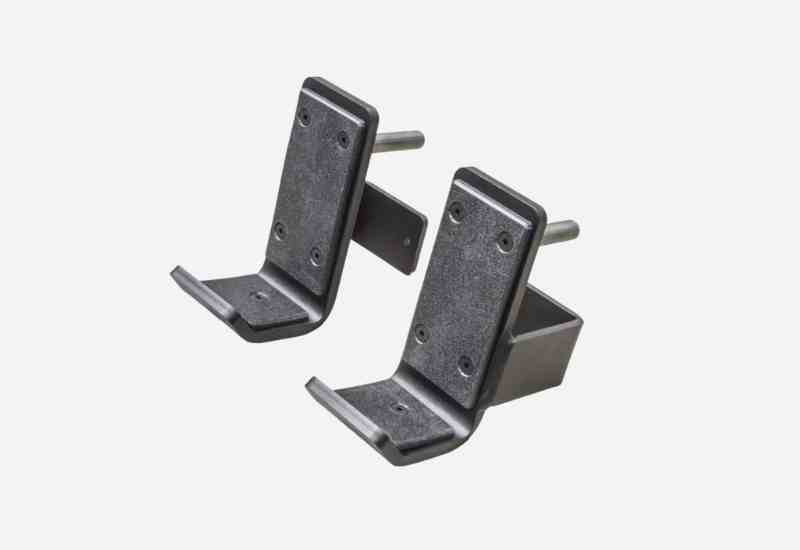
When ordering a set (or a second set, for that matter) look for plastic lining on the insert. This will protect both the j-cup and your barbell when racking and unracking the barbell.
Safety pins
Also called safety pipes, they extend the depth of your squat rack and act as a spotter.
Typically finished with chrome, safety pins are your last line of defense when squatting or pressing heavy, allowing you to lift with confidence.
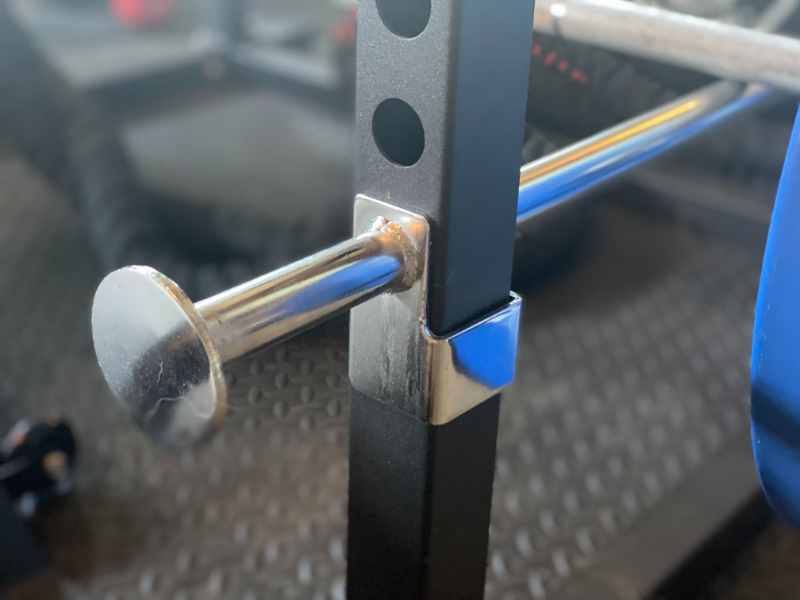
Safety pins mean you can lift inside the power rack knowing that even if you have to ditch the weight, the barbell won’t crash into the floor, damaging the floor, your lifting equipment, and your pride.
Safety straps
Safety straps have quickly become my preferred method of spotting my heavy lifts when lifting solo at home.
Compared to safety pins, straps absorb the weight of the barbell quietly (perfect for lifting heavily like a ninja when the kids are sleeping in the next room) and also reduce the shock of metal on metal impact when you have to ditch a barbell after a failed rep.
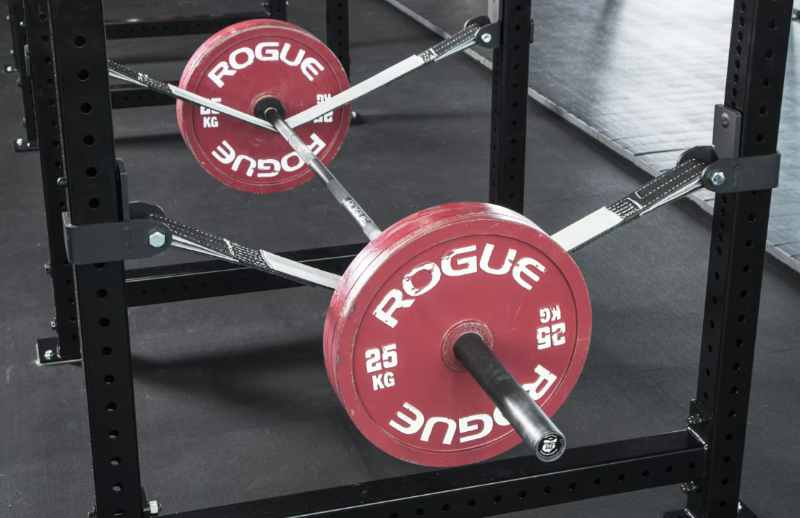
Safety straps are also exceptionally strong. The safety straps that Bells of Steel ships with their Commercial Power Rack 5.1 are rated for over 4,400lbs (!!).
For more information on the differences between spotter straps and safety pins, read this article.
Safety arms
Although safety arms look a lot like safety pins, they are significantly different.
For starters, they are often positioned on the outside of a power rack as a spotting tool (although you can just as easily set them up inside the rack, too).
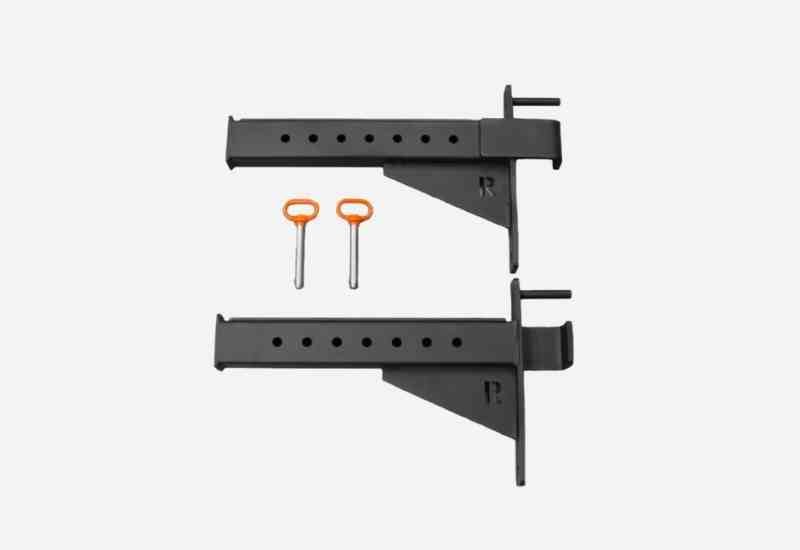
Using them outside the rack is a little dangerous, however, as dropping a fully loaded barbell outside the center of gravity of a rack (especially one that is not bolted down) will almost certainly cause the rack to wobble and possibly even tip over.
Storage Attachments for Your Power Racks
Now that we have covered the whole “safety first” stuff, let’s move on to some general storage and housekeeping attachments that can help keep your workout area tidy, protect your equipment, and even help stabilize your rack.
Weight plate pegs
Pegs for storing your bumper plates and cast iron plates are one of the first purchases everyone should make with their squat rack (if it’s not already included with the rack).
There are several excellent reasons to use these bad boys.
For starters, adding the pegs to the lower half of your squat rack and loading them with plates will increase the stability of the rack, especially if you have a free-standing or flat-footed squat rack that is not bolted down to the floor.
Secondly, weight pegs keep your plates off of the floor, removing a tripping hazard and keeping your workout area tidy.
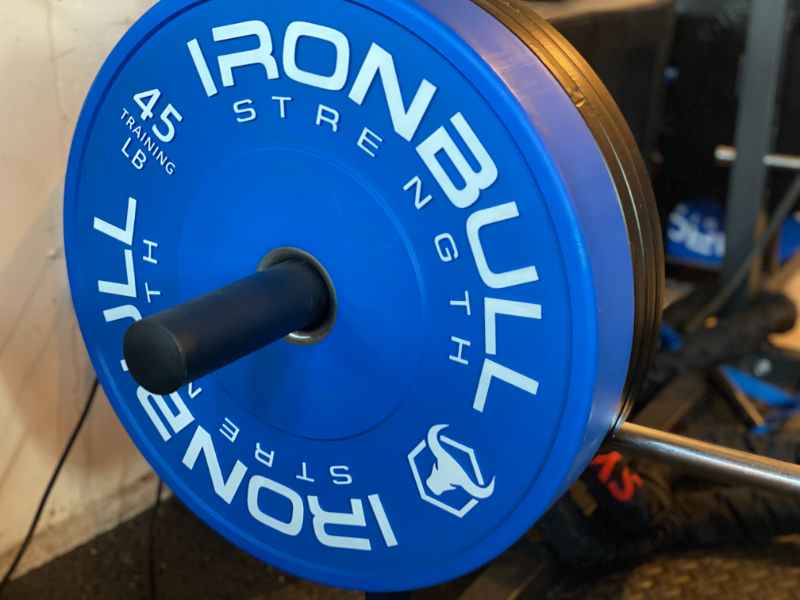
And finally, getting your plates off the floor between workouts decreases the amount of condensation and water vapor they encounter, lowering the risk of chrome and iron rusting on your plates.
Plate pegs are great for your bumpers, but they can also be used to hang other gym equipment such as weightlifting chains, heavy-duty resistance bands, barbell collars, and so on.
(Weight plates are also way easier to slide on and off a weight peg compared to peeling them individually off of the floor.)
Vertical bar holder
Barbells—whether we are talking about the more common Olympic barbell or the extra-stiff, heavy-lifting oriented powerlifting barbells—can be quite pricey.
With the bushings, the finishes, and the knurling on the bar, you want to keep them in tip top shape so that they keep carrying the weight over the years.
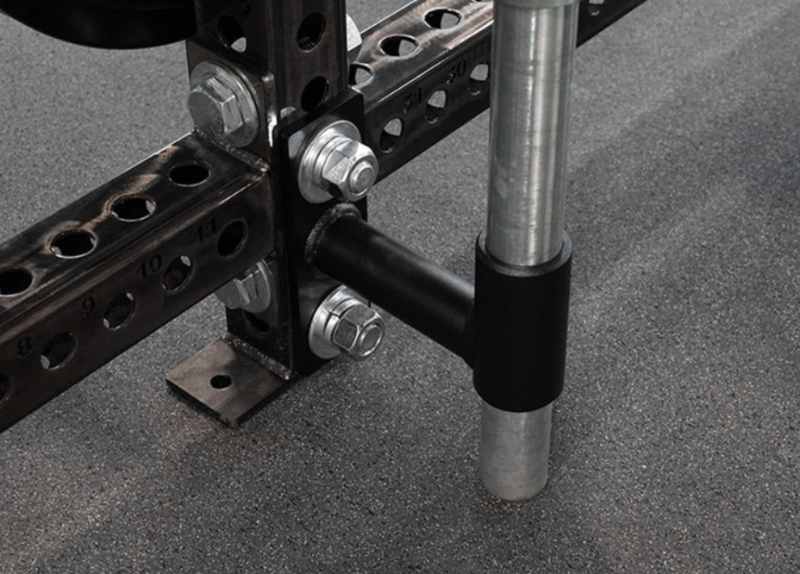
A vertical (or horizontal) bar holder makes for a tidy way to store your barbell between sessions in your home gym.
Chain and band holder
Hang up your weightlifting chains, heavy resistance bands, weight belt, or whatever else you’re working out with and keep the area around your rack nice and litter-free.
While there are dedicated holders for this task, you can also co-opt a resistance band peg for the same purposes of storage and hanging equipment.
Power Rack Accessories – The Goodies
Now that we have covered the true essential power rack accessories, it’s time to start looking at some of the attachments that we can use to make the rack a truly versatile, multi-exercise station of extreme gains and awesomeness.
There is a long list of attachments you can throw at your squat rack (Rogue, for example, at last count, offers 175 different rack attachments for the Monster line of squat racks), but I’ve included the most popular ones here in this list.
Beyond these, you start to get into the really specialized attachments, but these are some of the ones I recommend most lifters consider adding to their squat rack.
Upgraded pull-up bar
Pull-ups are my favorite upper body exercise. Hauling your bodyweight up into the sky is about a pure an expression of physical strength I can think of.
But the regular grip isn’t always easy on the wrists and elbows, which means that I prefer to use a multi-grip bar that allows neutral and other grip options.
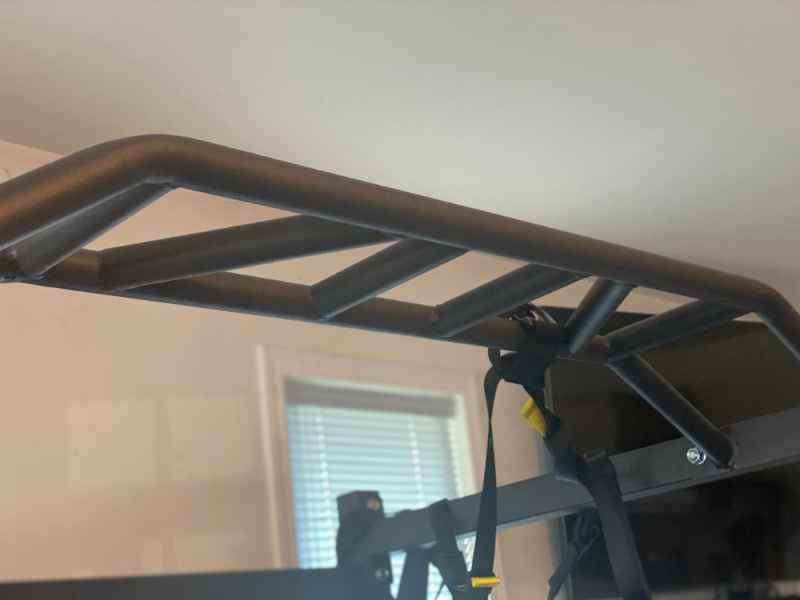
Some racks come packaged with a multi-grip bar (my first garage rack, made by ARMSTAFF, had one), but for many other rack companies, it’s an add-on at the time of purchase.
See also: The Best Squat Racks with Pull-Up Bars
Resistance Band Pegs
Adding bands to your lifts is a great way to increase time under tension and really hammer the top end of your lifts.
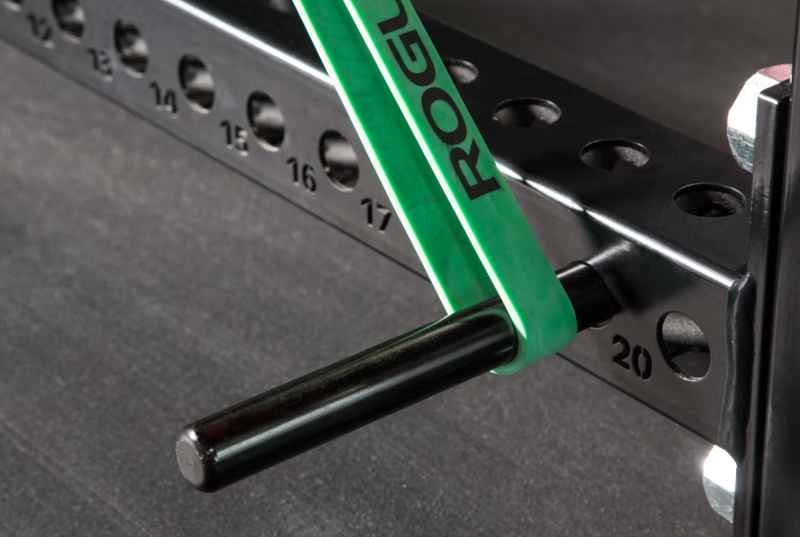
But resistance band pegs are also handy as a storage tool as they can be placed on the columns of the squat rack to hang equipment like–yes, you knew it was coming!—resistance bands, as well as your lifting belt of choice, lifting straps, barbell clamps, etc.
Landmine attachment
Landmine attachments look extremely simple—they are basically a barbell holder on a swivel—but the range of exercises you can introduce to your workouts are almost endless.
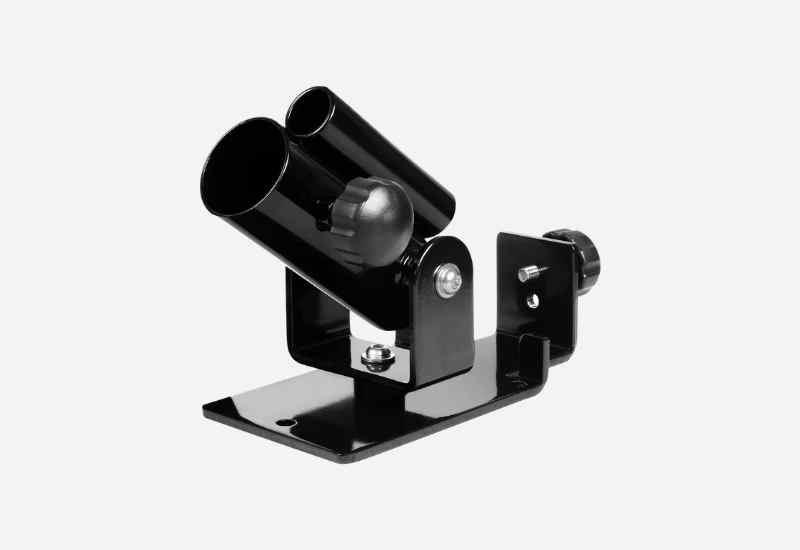
Single leg RDLs, single arm rows, double-hand rows, single leg squats, and so on.
They are also quite inexpensive as far as leveling up your squat rack goes.
Lat Pulldown Attachment
The lat pulldown exercise is one of the best ways to develop a stronger upper back and get that much vaunted V-shape in the shoulder and back.
While pull-ups are a more effective means of developing rabid upper body strength and back muscle, lat pulldowns are a better alternative for those of us who can’t bang out reps of pull-ups like they owe us money.
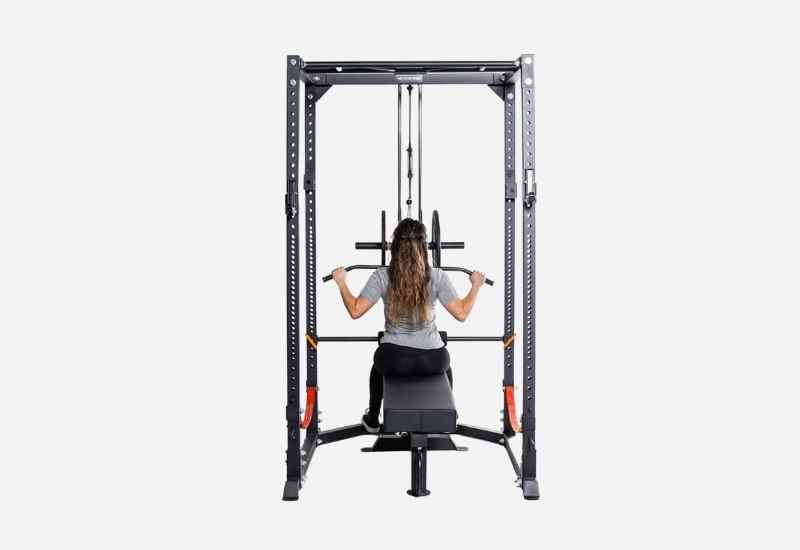
Lat pulldown attachments vary by brand, but they generally come as a pulley system with the ability to use both a lat pulldown and a low row with the attachment.
Simply add your weight plates to the weight pegs, set the pulley system to where you want it, grab the lat pulldown bar, and get to work.
Lat pulldown attachments are significantly cheaper than dedicated lat pulldown machinesv, which can quickly get into the $1,000+ range.
See also: 6 Best Power Racks with Lat Pulldown
Dip Station
Dips are a legendary upper body exercise that usually require either a dedicated dip bar or station or a trip to your local gym.
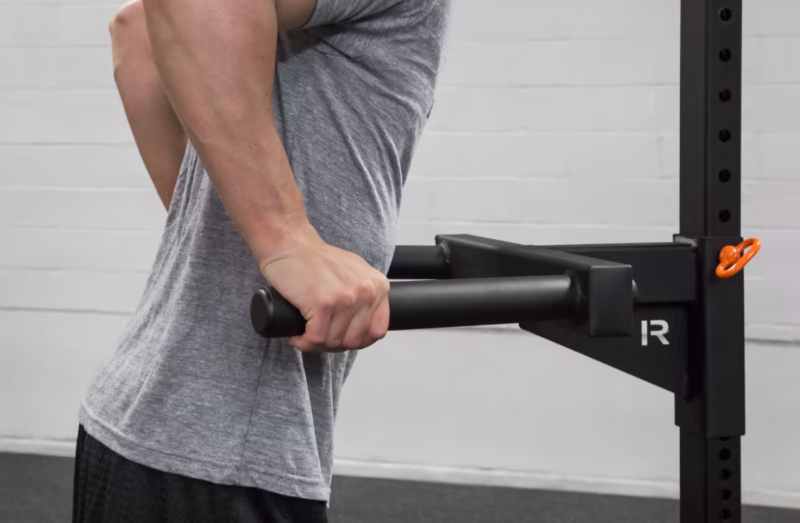
Fortunately, the simple design of dip bar attachments (also known as Y-bars, Matador bars, etc) means you can quite literally click the bar into your existing rack, converting it instantly into a way to do dips and leg raises.
Dip bars typically land in the range of $100-150, making them a no-brainer for the dip afficanado.
Monolift
Monolifts are designed to help boost your lift-off when it comes to your squats and bench press. They are basically fancy-pants J-hooks that eliminate that step back when you load a heavy barbell onto your back.
Users who aren’t confident with shuffling back with heavy squatting (or pressing) will like them.
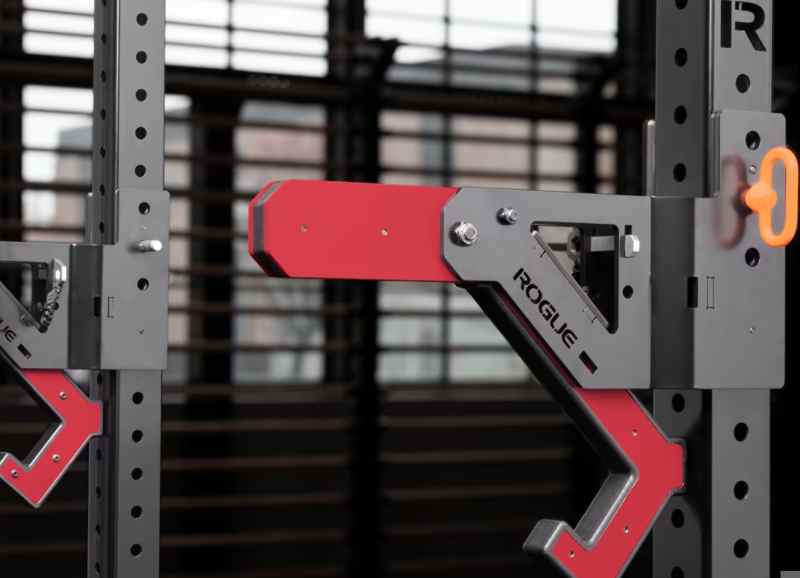
That said, Monolifts can be quite bulky and can take up a lot of room inside the squat rack.
Some models are also bolted on, which means that you can end up spending 10-15 minutes in the middle of your workout removing it from the rack.
Monolifts are also not cheap, often touching $400 territory when it comes to the price tag.
Lever arms
Lever arms are a neat-o tool for expanding the list of exercises you can do with a squat rack. Also known as ISO arms or hammer arms, these bad boys are longish arms that attach and move using a lever system.
Simply grip the handles, and you can start pushing weight around in a variety of planes.
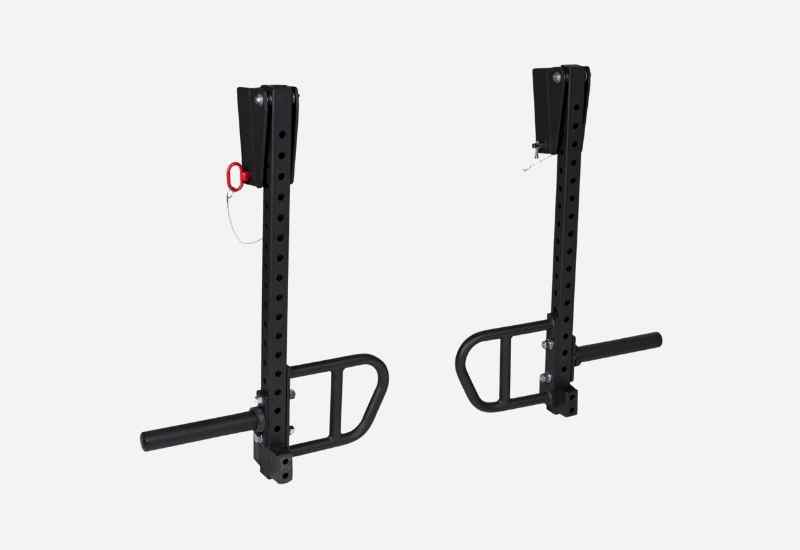
They basically you give the option to do exercises in the same manner as using the machines at your local gym.
Chest presses, unilateral presses, standing rows, RDLs, ISO seated rows… The list goes on. Lever arms can also be set anywhere on the columns, giving you ultimate versatility.
Like monolifts, they are on the pricier end of the spectrum.
Rogue’s lever arms start at $975, while Bells of Steel offers theirs for around $220.
Key Things to Remember When Shopping for Power Rack Attachments
Once you’ve settled on the type of attachments you want to use to dress up your squat rack, there are two things to check before donkey-punching that “add to cart” button:
⭐ How the attachment attaches
Attachments attach in three different ways: Bolt-on, twist and lock, or a pin lock.
Bolt-on attachments make them a quasi-permanent installation. With things like pull-up bars, this isn’t an issue as you want maximum fastness when hooking it up to your rack.
Attachments that latch on with a pin are my favorite option as they are way faster to decouple from the rack and they provide the same amount of stability and strength as a bolt-on attachment.
Twist and lock attachments are okay, but be weary of J-cups and safety-oriented bars that lock this way as they can be prone to twisting out of place when racking the barbell.
⭐ Upright thickness
This is perhaps the most important thing to remember when choosing out some aftermarket attachments for your squat rack—the thickness of the column of your squat rack!
Racks come with varying levels of column width, with the less expensive options featuring a 2” x 2” frame, while the more heavy-duty, commercial-grade racks use 3” x 3” columns.
There are also brands that use “off” sizes, including Bells of Steel with 2.3” x 2.3” frames, and Rogue’s racks come in both 2” x 3” and 3” x 3” sizes.
Double and triple check the attachments you are looking at will fit your particular squat rack.
Where to Buy Squat Rack Attachments
Here is where to buy squat rack attachments for the most popular racks on the market right now:
✅ Rogue Fitness Squat Rack Accessories
✅ Bells of Steel Squat Rack Attachments
✅ Titan Fitness Squat Rack Attachments and Accessories
✅ REP Fitness Power Rack Attachments
✅ Iron Bull Strength Squat Rack Accessories
✅ Squat Rack Attachments at Amazon (All Brands)
✅ Force USA Power Rack Attachments
More Power Rack Guides
How Much Space Do You Need for a Power Rack? Wondering how much space you should set aside for a power rack? Here are the key things to focus on to get it right the first time.
What Should I Put Under My Power Rack? Putting something under your power rack protects your weights, your floor, and makes lifting safer. Here’s a look at what kind of flooring to use with your power rack.
7 Best Exercises You Can Do With a Squat Rack. Squat racks are an essential tool for tackling all of your favorite lifts more safely. Here’s a look at the best exercises you can do with a squat rack, plus a sample workout routine for the next time you step inside the rack.